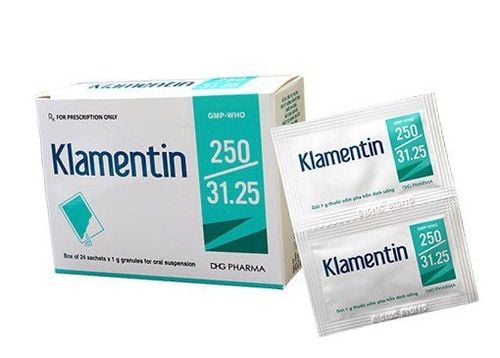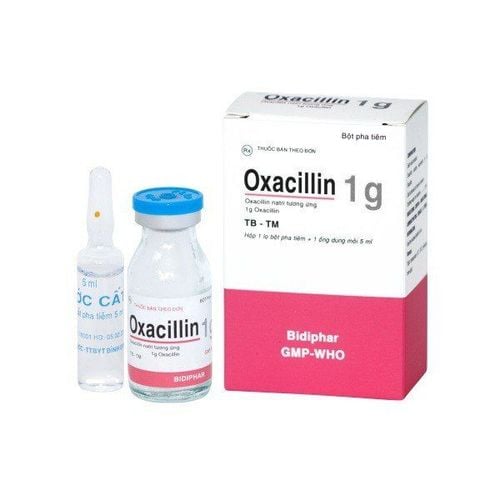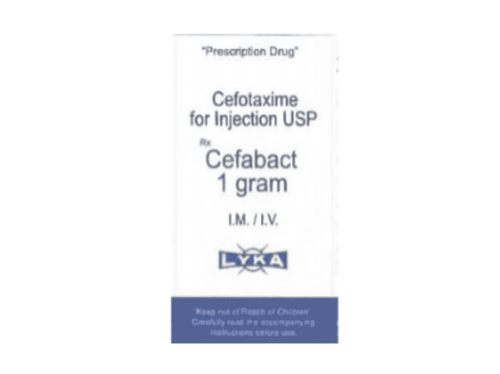This is an automatically translated article.
Kontaxim Inj is a powder for injection, belonging to the group of drugs to treat parasites, anti-infectives, antivirals, antifungals. Kontaxim Inj drug is often indicated in the treatment of bacterial infections of the skin and soft tissue, bones, joints or blood.
1. What is Kontaxim Inj?
Kontaxim Inj has the main ingredient is Cefotaxime 1g (in the form of Cefotaxime sodium), which is commonly used in the treatment of diseases such as:
Treatment of serious and critical infections caused by bacteria sensitive to cefotaxime such as cefotaxime such as: : sepsis, brain abscess, meningitis (except meningitis caused by Listeria monocytogenes), endocarditis, pneumonia. Treatment of gonorrhea, typhoid. Severe intra-abdominal infections when used in combination with metronidazole and to prevent infection after prostatectomy including laparoscopic surgery, cesarean section.
2. Dosage and how to use Kontaxim Inj
2.1. How to use Kontaxim Inj Kontaxim Inj drugs used by intramuscular injection or injection, slow intravenous infusion. Specifically, intravenous injection from 3 to 5 minutes and intravenous infusion from 20 to 60 minutes.
How to make solution:
Use for intravenous injection: Dissolve 1 g of the drug in 10 ml of distilled water for injection, inject intravenously for 3 to 5 minutes. Use for continuous intravenous infusion: When high doses are needed, dissolve 2g in 100ml with one of the solutions such as sodium chloride 0.9%, ringer lactate glucose 5%, dextrose 5% and time intravenous infusion over 50 to 60 minutes. Rapid intravenous infusion: Dilute in 40ml of infusion solution such as glucose 5%, sodium chloride 0.9%, dextrose 5%, ringer lactate and infuse over about 20 minutes. Note, patients do not use sodium bicarbonate solution to mix cefotaxime sodium injection solution. Intramuscular: Dissolve 1 g in 4 ml of distilled water for injection. In case of multiple intramuscular injections on the same site, the patient should not inject more than 4ml for adults and 2ml for children. Note:
Cefotaxime should be administered intravenously if the dose is greater than 2g/day for adults and 100mg/kg for children. To relieve muscle pain, patients can mix intramuscular solution for adults and children over 12 years old with 1% lidocaine solution (1g - 4ml). Drug solutions containing lidocaine should not be administered intravenously. 2.2. Dosage Kontaxim Inj The usual dose is from 2 to 6g divided into 2 or 3 times / day. For patients with severe infections, the dose can be increased to 12g per day, administered intravenously divided into 3-6 times. The usual dose for patients with green pus infection is over 6g/day. The usual dose for children: 100-150mg/kg daily, 50mg/kg for infants, 2-4 times a day. Dosage in patients with renal impairment: The dose of cefotaxime should be reduced in patients with severe renal impairment when the creatinine clearance is less than 10 ml/min. Note: The initial dose of the drug can be kept the same, but subsequent doses need to be reduced by half - the maximum daily dose is 2g. Dosage in the treatment of gonorrhea: Use a single dose of 1g. Prevention of postoperative infection: Use 1g injection 30 to 90 minutes before surgery. Patients with caesarean section should inject 1g intravenously immediately after clamping the pedicle, and after 6 and 12 hours, two more doses should be injected intramuscularly or intravenously. Duration of treatment: The duration of drug use is long or short, depending on the progression of the disease, the average duration of drug use is from 3 to 4 days. Specifically, when treating infections caused by group A beta-hemolytic streptococci, the duration of treatment is 10 days. Infections that are long-term and do not go away require treatment for a longer period of time.
3. Notes when using Kontaxim Inj
After mixing the drug, it should be used immediately, not to change color because of the loss of the drug's effectiveness. Patients should do a skin test first to predict possible drug sensitivity prior to injecting cefotaxime. Patients should be tested for bacterial susceptibility to the drug to avoid drug resistance and possibly shorten the duration of treatment. When the drug is administered intravenously, a venous thromboembolic reaction or vasospasm may occur. Therefore, patients need to regularly monitor their health when injecting drugs. When using intramuscular injection, if lidocaine is not added, it may cause a painful swelling reaction at the injection site. In case the patient is in shock, emergency treatment should be given immediately. Place the patient in a supine position for ventilation and use high-dose corticosteroids for general treatment. After that, you still need to continue to monitor your health.
4. Be careful when using Kontaxim Inj
Before using Kontaxim Inj, the patient should be carefully checked for a history of allergy to drugs such as Cephalosporin, Penicillin or to other drugs. There has been a cross-allergy between penicillin and cephalosporin. Caution should be exercised in patients receiving Cefotaxime who are allergic to penicillin. If the drug is used concomitantly with nephrotoxic drugs such as aminoglycosides, renal function should be monitored regularly. Cefotaxime may interfere with laboratory results, causing false positives in the Coombs test with tests of urinary tract and reducing agents without the use of enzymatic methods. Cefotaxime should be used with caution in patients with a history of gastrointestinal disease, especially colitis. When using antibiotics often patients will experience diarrhea, but this reaction will end when the drug is stopped. However, if persistent diarrhea accompanied by watery and bloody stools occurs within 2 months or longer from the last dose, the patient should notify the doctor for treatment. . Clinical studies have reported that approximately 1% of patients receiving cefotaxime will develop leukopenia/granulocytosis or thrombocytopenia. Therefore, it is necessary to monitor the blood cell counts in patients during treatment lasting more than 10 days. Cefotaxime causes headache, agitation, confusion, and seizures in about 1% of patients taking the drug. In particular, potentially life-threatening arrhythmias have also been reported in some patients receiving rapid bolus administration of cefotaxime (< 1 min) via a central venous catheter.
5. Kontaxim Inj . side effects
Common side effects: Causes diarrhea, thrombophlebitis at the injection site, pain and inflammatory reactions at the site of intramuscular injection. Uncommon side effects: Decreased eosinophils or leukopenia, affecting the results. Coombs test results, changes in gut bacteria, superinfection reactions caused by resistant bacteria such as Enterobacter or Pseudomonas aeruginosa. Rare side effects: Anaphylaxis, hypersensitivity reactions, thrombocytopenia/granulocytosis, hemolytic anemia, Clostridium difficile pseudomembranous colitis, increased bilirubin and liver enzymes in the liver. plasma. How to handle:
When experiencing the above reactions, the patient should stop using Kontaxim Inj and consult a doctor. Prophylaxis of phlebitis due to injection: May be administered by injection or by slow intravenous infusion. To relieve pain caused by intramuscular injection: Lidocaine and Cefotaxime should be mixed immediately before injection
6. Drug interactions
May increase the risk of kidney damage due to the combination of antibiotics of the Cephalosporin group with Colistin of the Polymyxin group. Cefotaxime in combination with Penicillin: If Azlocillin is used concomitantly with patients with renal failure, it may cause encephalopathy and partial seizures. Cefotaxime and ureido - Penicillins such as Azlocillin or Mezlocillin: The use of these drugs together will reduce the clearance of Cefotaxime in patients with impaired renal function and those with normal renal function. Therefore, it is necessary to reduce the dose of Cefotaxime if these drugs are used in combination. Concomitant administration of Probenecid with Cefotaxime resulted in high and prolonged serum concentrations. Concomitant use of aminoglycosides and cefotaxime increases the risk of nephrotoxicity, so patients should be treated with caution. Use in pregnancy: Safety in pregnancy has not been established. The drug has the ability to cross the placenta during the second trimester of pregnancy. The elimination time of Cefotaxime in fetal serum and amniotic fluid is 2.3 - 2.6 hours. So it can affect the development of the fetus. Therefore, when using the drug for pregnant women need to be careful. Using the drug with breast-feeding women: Research has shown that Cefotaxime is excreted in breast milk at low concentrations, but the drug can still cause some unwanted side effects for the baby such as changing bacteria. in the intestinal tract, affecting the results of bacterial cultures when the child has a fever. Above is information about Kontaxim Inj drug, dosage and note when using. To ensure safety for your health and maximize the effectiveness of your treatment, you need to take Kontaxim Inj exactly as directed by your doctor.
Please dial HOTLINE for more information or register for an appointment HERE. Download MyVinmec app to make appointments faster and to manage your bookings easily.













